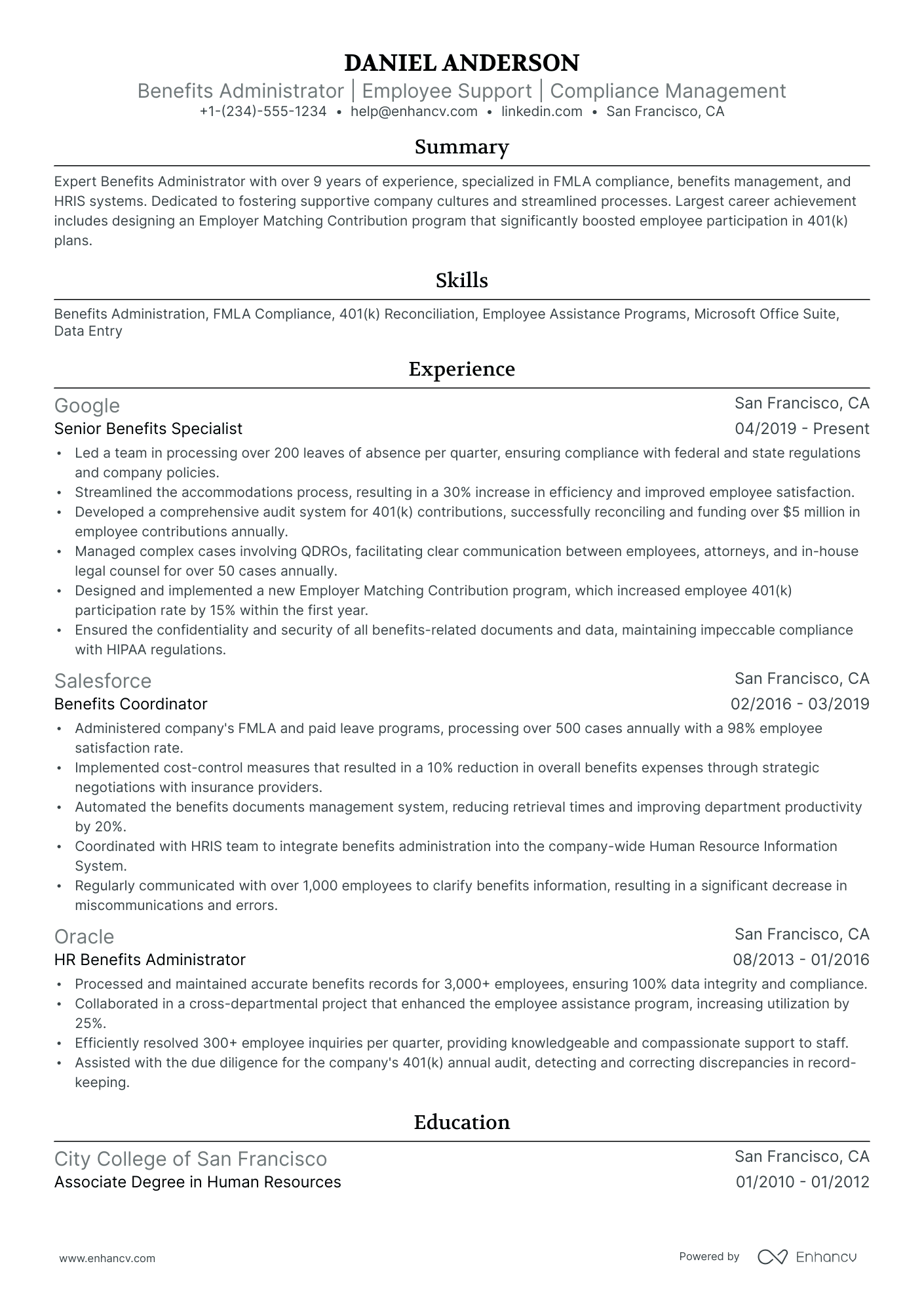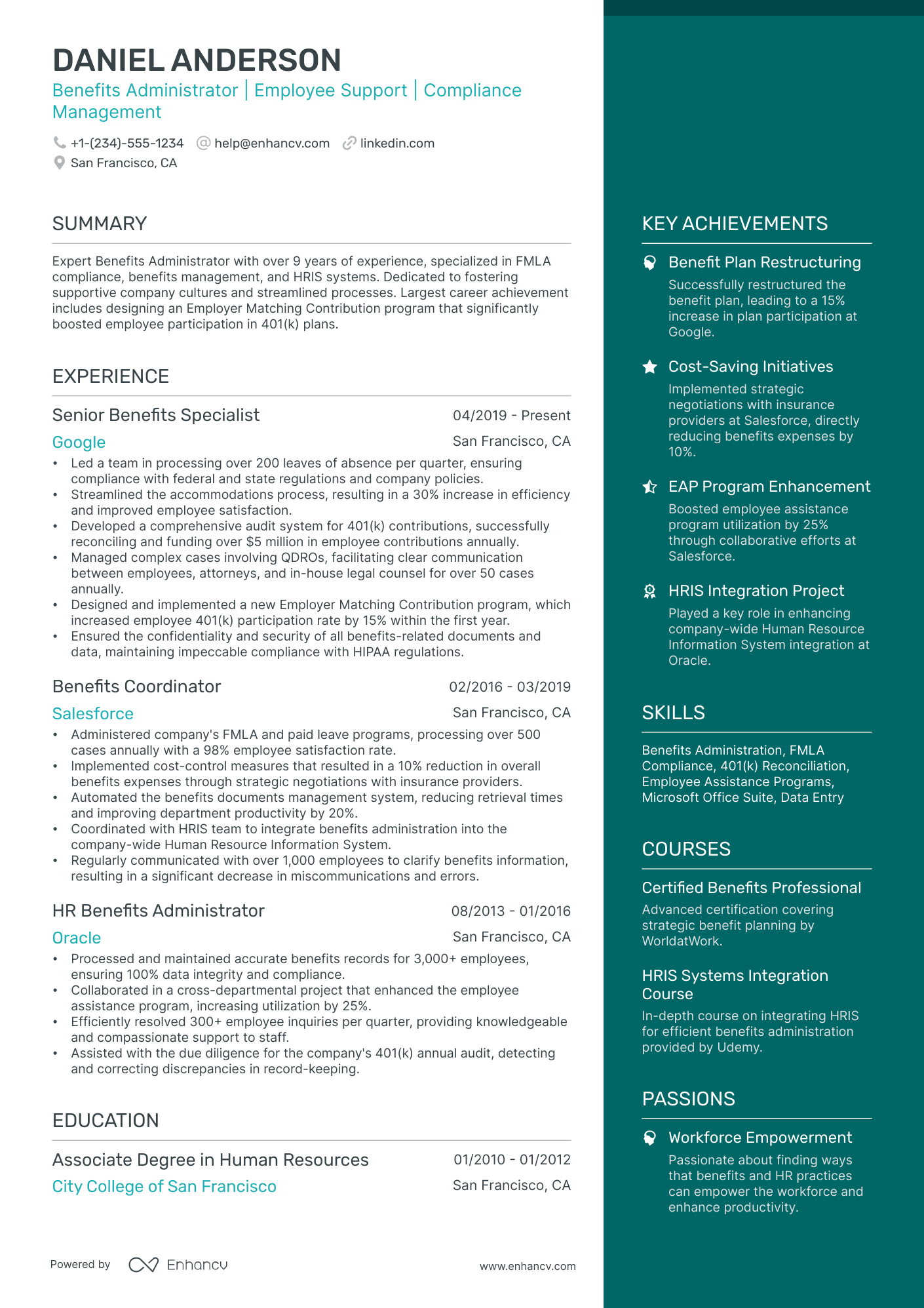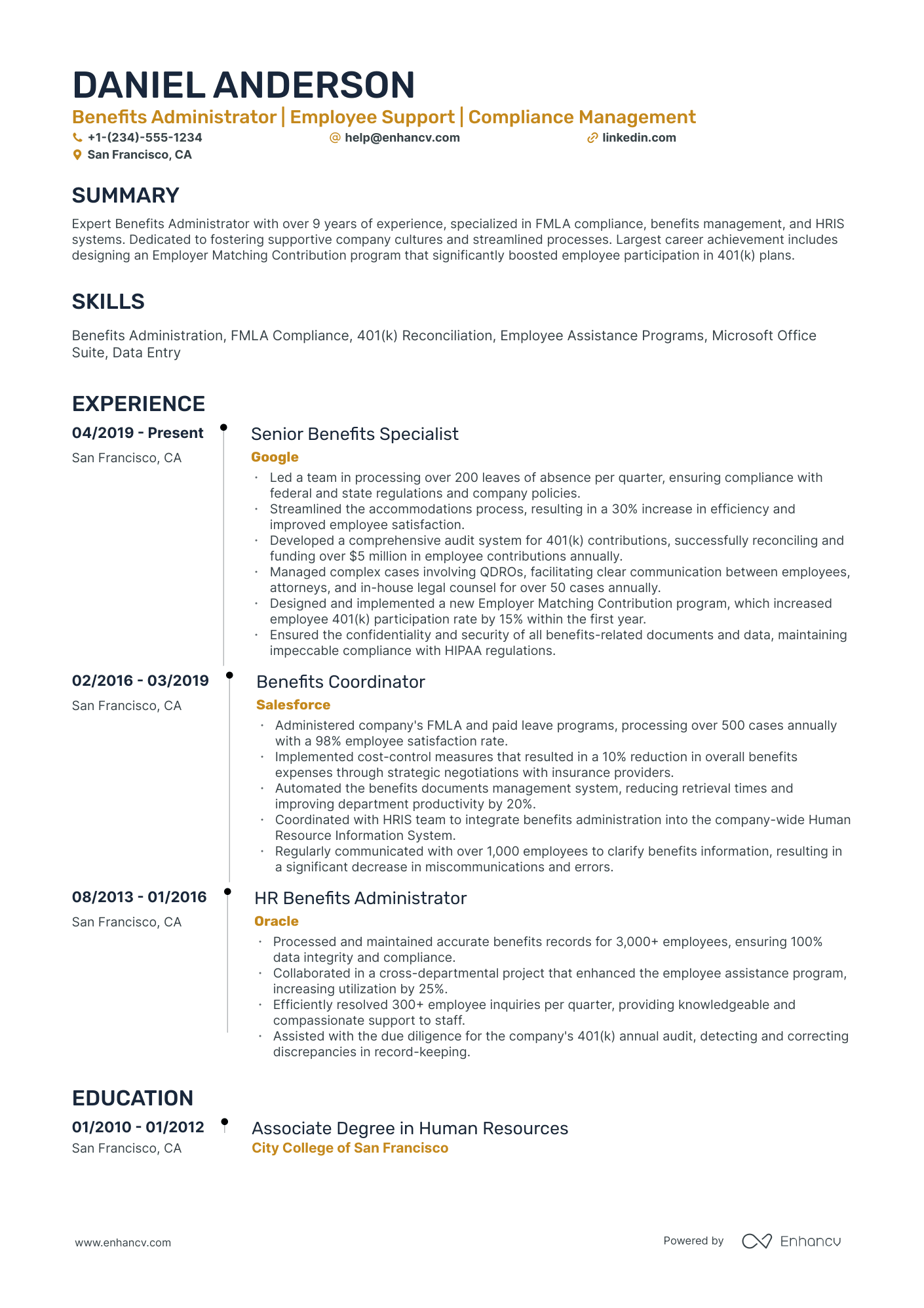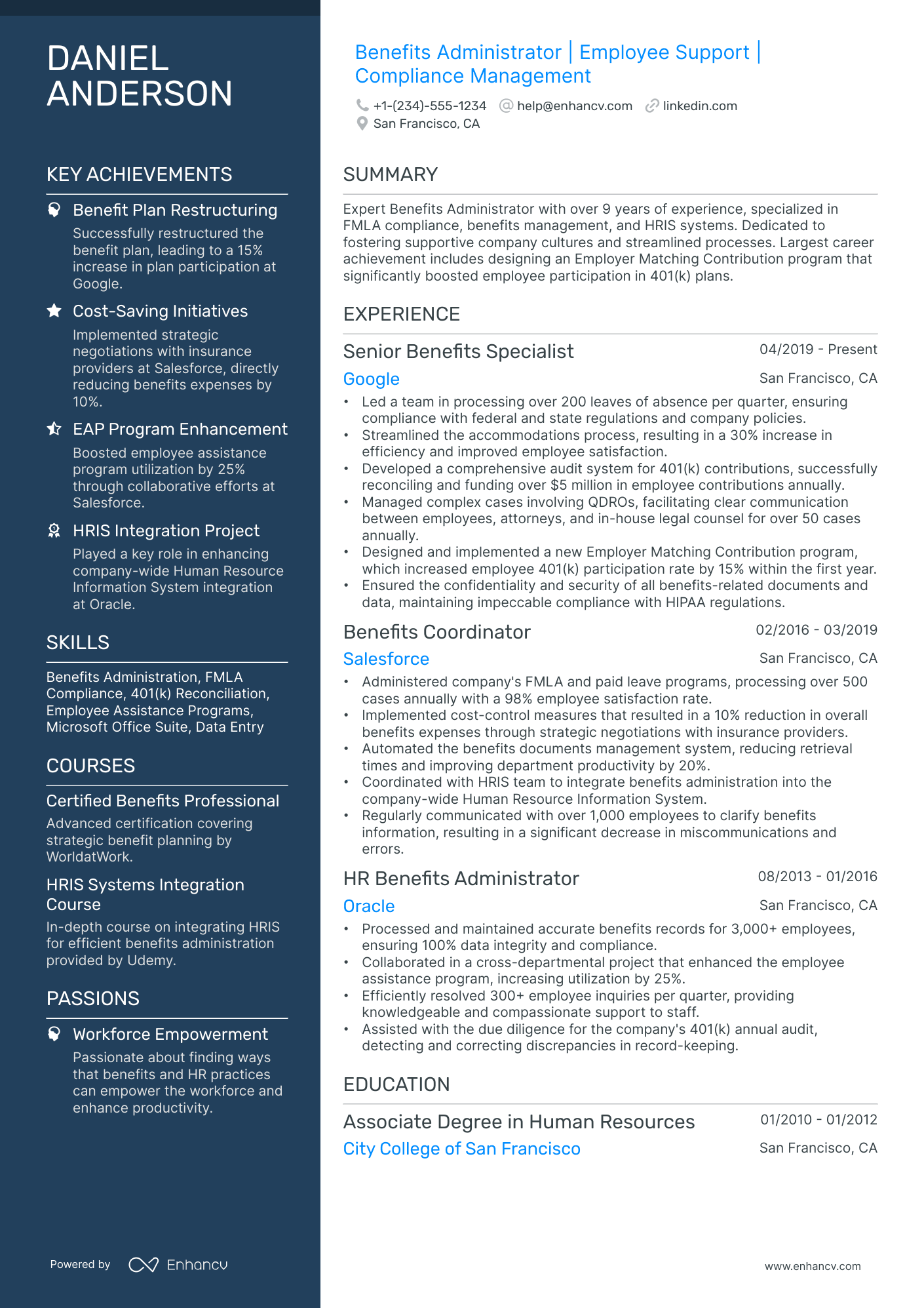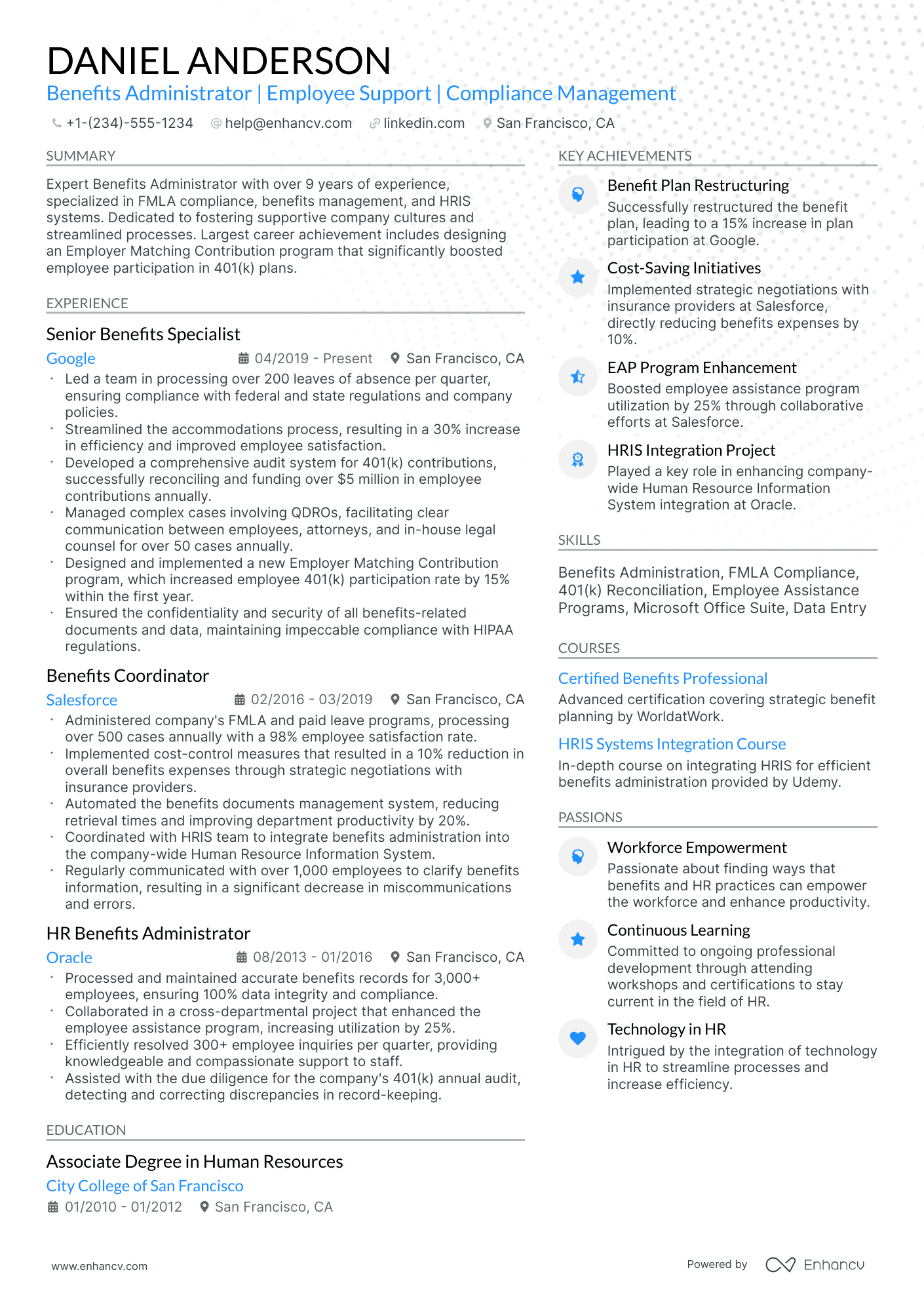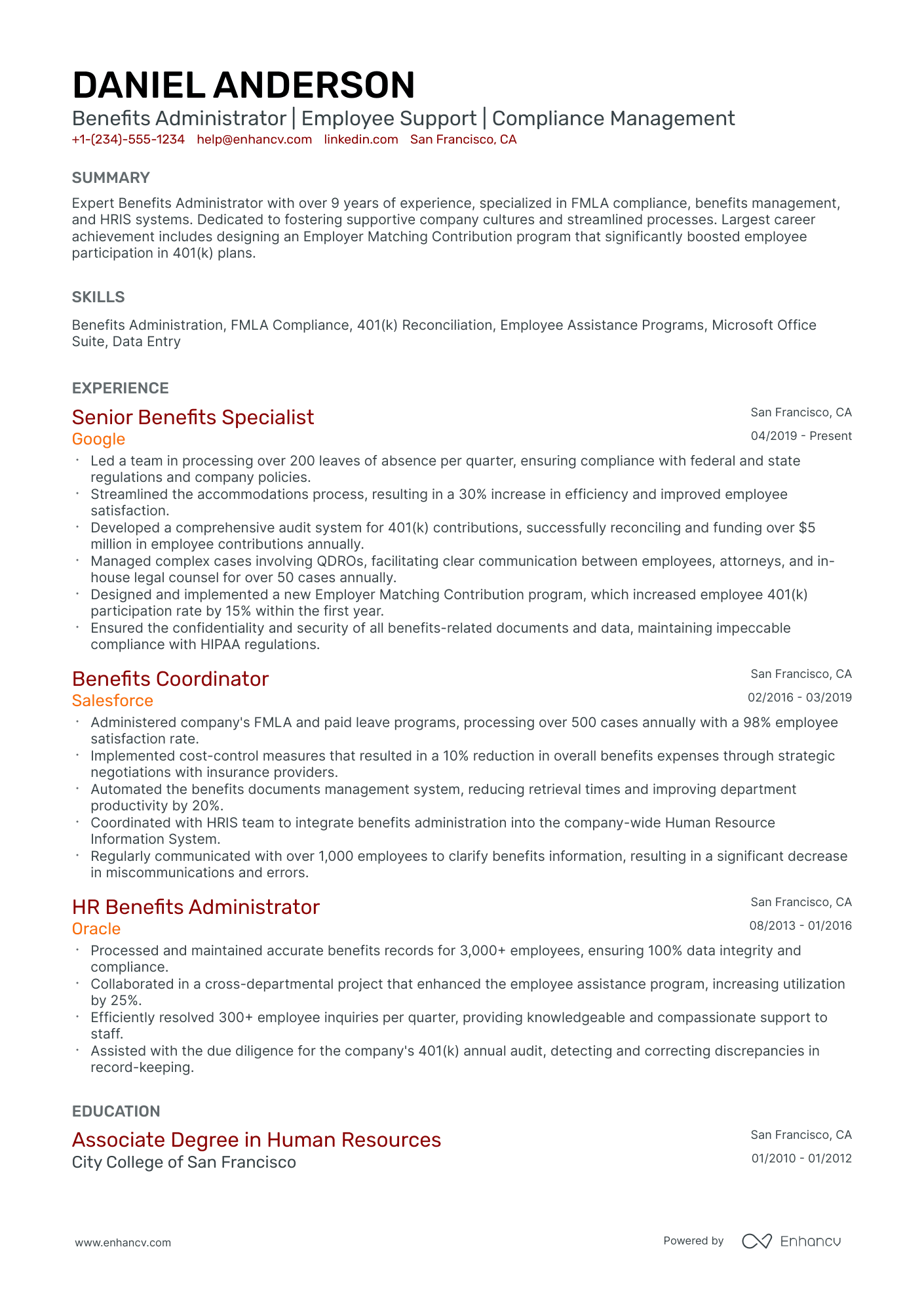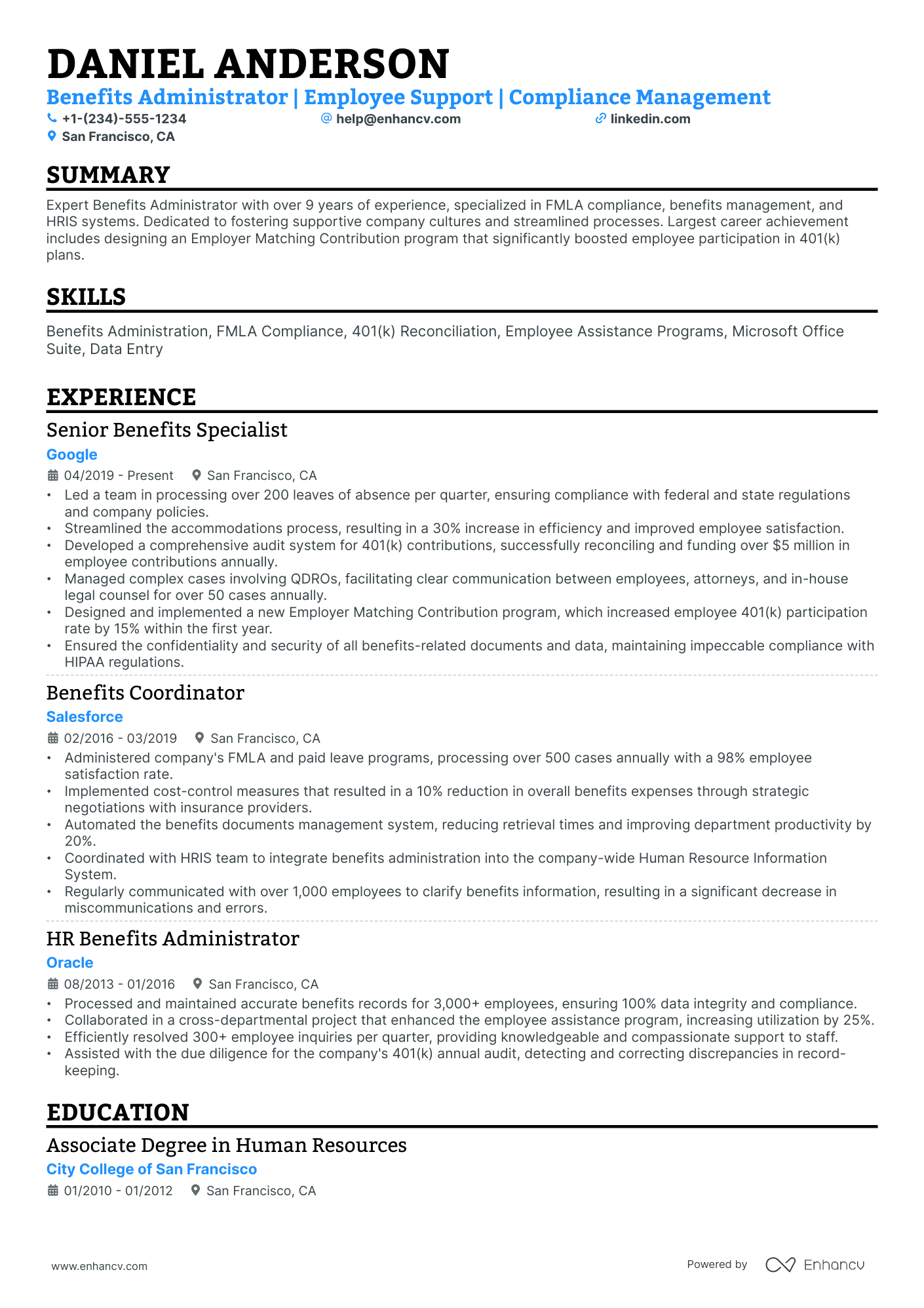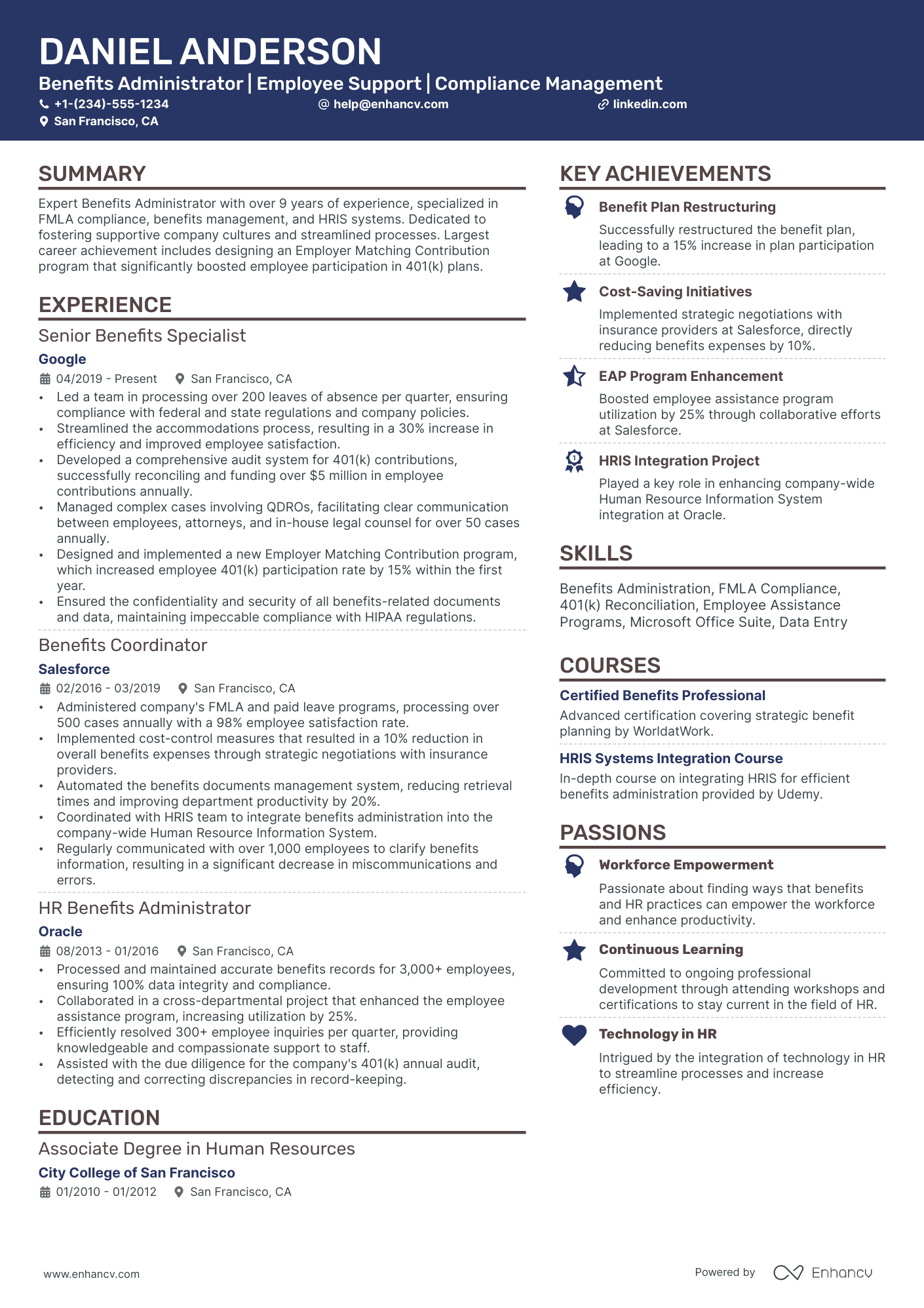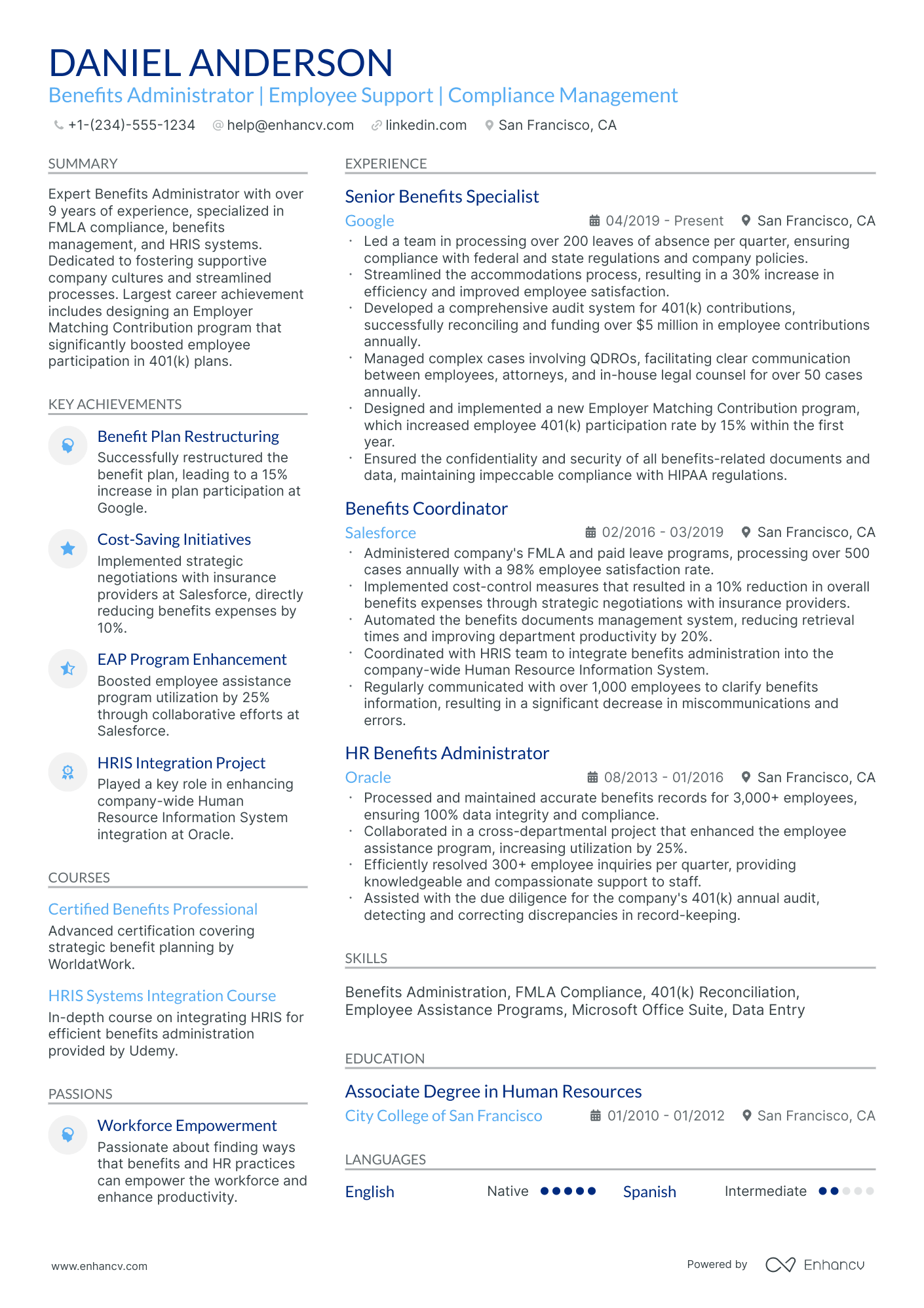One resume challenge you might encounter as a benefits analyst is effectively showcasing your analytical skills and ability to manage complex benefits programs. Our guide provides targeted tips and examples to help you highlight your expertise and convey the impact of your work, making your resume stand out to potential employers.
- Sample industry-leading examples to learn how to write your best resume yet.
- Improve the experience, education, and achievements section of your resume with insights from resume-writing professionals.
- Curate your technical expertise and personality to stand out amongst the pool of candidates.
- Succinctly focus on your unique skill set all through your benefits analyst resume.
If the benefits analyst resume isn't the right one for you, take a look at other related guides we have:
- HR Business Partner Resume Example
- Transition Manager Resume Example
- Training Manager Resume Example
- Recruitment Manager Resume Example
- HR Generalist Resume Example
- HR Project Manager Resume Example
- HR Program Manager Resume Example
- Recruiting Coordinator Resume Example
- District Manager Resume Example
- HR Director Resume Example
How to style your benefits analyst resume: layout and format
When creating your benefits analyst resume, have you ever wondered how long it should be? Experts point out that it should be between one and two pages. Choose the longer format, if you happen to have over a decade of relevant experience. What is more, resume formats play a crucial role in presenting your experience. Use the:- Reverse-chronological resume format to highlight your experience;
- Functional skill-based resume format if you have less experience and want to focus on skills;
- Hybrid resume format to guide recruiters through both your experience and skills.
- Make sure your headline is simple and includes the job you're applying for or your current role, an abbreviation of a certificate you have, or even your professional area of interest;
- Always tailor your benefits analyst resume to the role you're applying for by matching job requirements to your experience via different resume sections;
- Once you've created your resume, download it in PDF (unless otherwise specified). This is to ensure readability and that the layout remains fixed.
Different markets have specific resume styles – a Canadian resume, for instance, may require a different approach.
Upload & Check Your Resume
Drop your resume here or choose a file. PDF & DOCX only. Max 2MB file size.
PRO TIP
The more trusted the organization you've attained your certificate (or degree) from, the more credible your skill set would be.
Don't forget to include these six sections on your benefits analyst resume:
- Header and summary for your contact details and to highlight your alignment with the benefits analyst job you're applying for
- Experience section to get into specific technologies you're apt at using and personal skills to deliver successful results
- Skills section to further highlight how your profile matches the job requirements
- Education section to provide your academic background
- Achievements to mention any career highlights that may be impressive, or that you might have missed so far in other resume sections
What recruiters want to see on your resume:
- Experience in benefits administration and knowledge of different types of benefit programs (e.g., health insurance, retirement plans, wellness programs).
- Proficiency with Human Resource Information Systems (HRIS) and benefits management software.
- Understanding of compliance and familiarity with employment laws and regulations related to benefits (e.g., ERISA, ACA, FMLA).
- Strong analytical and problem-solving skills to evaluate benefits plans, vendors, and cost-effectiveness.
- Exceptional communication and interpersonal skills to effectively convey benefits information to employees and negotiate with vendors.
Adding your relevant experience to your benefits analyst resume
If you're looking for a way to show recruiters that your expertise is credible, look no further than the resume experience section.
Your benefits analyst resume experience can be best curated in a structured, bulleted list detailing the particulars of your career:
- Always integrate metrics of success - what did you actually achieve in the role?
- Scan the benefits analyst advert for your dream role in search of keywords in the job requirements - feature those all through your past/current experience;
- Dedicate a bullet (or two) to spotlight your technical capabilities and how you're able to use the particular software/technology in your day-to-day roles;
- Write simple by including your responsibility, a job advert keyword or skill, and a tangible outcome of your success;
- Use the experience section to also define the unique value of working with you in the form of soft skills, relevant feedback, and the company culture you best thrive in.
Industry leaders always ensure that their resume experience section offers an enticing glimpse at their expertise, while telling a career narrative. Explore these sample benefits analyst resumes on how to best create your resume experience section.
- Managed comprehensive benefits analysis for a workforce of 5,000, optimizing plan selections and contributing to an annual cost-saving of 15%.
- Led the implementation of a new wellness program that boosted employee participation by 30% and reduced healthcare claims by 20%.
- Spearheaded a benefits data integration project with IT, enhancing the accuracy of benefits data by 25% and streamlining the enrollment process.
- Conducted quarterly benefits plan performance reviews, presenting findings to upper management and recommending strategic adjustments which improved employee satisfaction ratings by 10%.
- Negotiated with insurance carriers to realize a reduction in premium rates by 8%, simultaneously maintaining plan quality.
- Developed and delivered training to HR representatives across the company, enhancing understanding of benefits plans and streamlining employee support procedures.
- Evaluated and benchmarked employee benefit programs against market trends, ensuring competitive positioning in the marketplace and aiding in talent retention.
- Implemented a cloud-based benefits management system, reducing paperwork by 40% and improving operational efficiency.
- Collaborated with cross-functional teams to ensure regulatory compliance across all benefits offerings, decreasing compliance-related issues by 15%.
- Analyzed employees' usage of benefits, identifying underutilized programs and initiating targeted communication campaigns that lead to a 20% increase in utilization.
- Led the annual benefits open enrollment process for a multi-state organization, enhancing employee engagement and reducing last-minute enrollments by 50%.
- Designed and executed a financial impact analysis of benefits changes, which supported the management decision-making process and helped maintain an average annual cost increase below 4%.
- Oversee the leave administration process, reducing the case resolution time by 25% and improving employee experience during their leave period.
- Analyze and report on benefit plan cost trends quarterly, providing insights that contributed to an organizational strategic shift towards high-deductible health plans.
- Coordinated with external consultants to conduct a comprehensive market analysis, resulting in the realignment of benefits that were 10% more cost-effective.
- Performed annual audits of benefits programs, identifying discrepancies that resulted in recovering over $200,000 in overpayments to benefits providers.
- Played a key role in the due diligence process during company mergers, integrating benefits plans and ensuring seamless transition for employees.
- Developed a series of financial models for predicting the impact of benefits changes on organizational expenses, enhancing the budgeting accuracy by 18%.
- Facilitated the design and launch of a new employee stock purchase plan, increasing employee investment options and contributing to a 12% rise in plan participation.
- Conducted annual benefits surveys and focus groups to gauge employee satisfaction, leading to a tailored benefits package that saw a 95% satisfaction rate.
- Oversaw the integration of the benefits administration platform with the new HRIS system, improving data transfer efficiency by 35%.
- Revamped the disability benefits process to shorten approval times by 40%, directly enhancing employee experience during difficult periods.
- Partnered with IT to develop an interactive benefits dashboard for employees, resulting in a significant increase in employee engagement with their benefits options.
- Identified cost savings opportunities in the company's retirement benefits plan, adjusting investment options and fees to save the company an average of $250,000 annually.
The following content includes information from "O*NET OnLine" by the U.S. Department of Labor, Employment and Training Administration (USDOL/ETA). Used under the CC BY 4.0 license. The data represents the top responsibilities present on the task lists for benefits analyst professionals.
Top Responsibilities for Benefits Analyst:
- Administer employee insurance, pension, and savings plans, working with insurance brokers and plan carriers.
- Ensure company compliance with federal and state laws, including reporting requirements.
- Research employee benefit and health and safety practices, and recommend changes or modifications to existing policies.
- Advise managers and employees on state and federal employment regulations, collective agreements, benefit and compensation policies, personnel procedures, and classification programs.
- Plan and develop curricula and materials for training programs and conduct training.
- Assist in preparing and maintaining personnel records and handbooks.
- Develop and administer compensation programs, such as merit or incentive pay.
- Evaluate job positions, determining classification, exempt or non-exempt status, and salary.
- Prepare occupational classifications, job descriptions, and salary scales.
- Consult with, or serve as, technical liaison between business, industry, government, and union officials.
Quantifying impact on your resume
- Include the number of benefit plans you have analyzed and recommended to showcase the breadth of your expertise.
- List the percentage improvement in employee satisfaction or participation due to your benefit program implementations.
- Specify the amount of cost savings achieved for the company through benefit plan negotiations or restructuring.
- Mention the number of benefit compliance audits you've successfully completed to highlight your attention to regulatory adherence.
- Quantify the volume of claims you've processed or disputes you've resolved to demonstrate your efficiency and problem-solving skills.
- State the size of the employee populations you've served to indicate your ability to manage large-scale projects.
- Detail the amount of training sessions or workshops you've led on benefits education to emphasize your communication and leadership abilities.
- Present the number of benefits software tools you’re proficient in to underscore your technical capabilities.
Action verbs for your benefits analyst resume
Experience section for candidates with zero-to-none experience
While you may have less professional experience in the field, that doesn't mean you should leave this section of your resume empty or blank.
Consider these four strategies on how to substitute the lack of experience with:
- Volunteer roles - as part of the community, you've probably gained valuable people (and sometimes even technological capabilities) that could answer the job requirements
- Research projects - while in your university days, you may have been part of some cutting-edge project to benefit the field. Curate this within your experience section as a substitute for real-world experience
- Internships - while you may consider that that summer internship in New York was solely mandatory to your degree, make sure to include it as part of your experience, if it's relevant to the role
- Irrelevant previous jobs - instead of detailing the technologies you've learned, think about the transferable skills you've gained.
Recommended reads:
PRO TIP
If the certificate you've obtained is especially vital for the industry or company, include it as part of your name within the resume headline.
Balancing hard and soft skills in your benefits analyst resume
Recruiters indeed pay close attention to the specific hard and soft skills candidates possess. Hard skills refer to technical abilities or your proficiency in technologies, while soft skills are the personal attributes and qualities developed over your lifetime.
If you're unsure about effectively quantifying these skills on your resume, follow our step-by-step guide. It's crucial to first understand the key job requirements for the role. Doing so enables you to accurately list your:
- Hard skills in sections like skills, education, and certifications. Your technical expertise is straightforward to quantify. Most organizations find it sufficient to mention the certificates you've earned, along with your proficiency level.
- Soft skills within your experience, achievements, strengths, etc. Defining interpersonal communication traits in your resume can be challenging. Focus on showcasing the accomplishments you've achieved through these skills.
Remember, when tailoring your benefits analyst resume, ensure that the skills you list match exactly with those in the job requirements. For instance, if the job listing specifies "Microsoft Word," include this exact term rather than just "Word" or "MSO."
Top skills for your benefits analyst resume:
HRIS Software (e.g., Workday, ADP)
Data Analysis Tools (e.g., Excel, SQL)
Benefits Administration Systems
Compliance Knowledge (e.g., ERISA, ACA)
Survey and Reporting Tools
Project Management Software
Presentation Software (e.g., PowerPoint)
Statistical Analysis Software (e.g., SPSS, R)
Employee Self-Service Portals
Cost-Benefit Analysis Techniques
Attention to Detail
Analytical Thinking
Communication Skills
Problem-Solving
Interpersonal Skills
Time Management
Team Collaboration
Adaptability
Customer Service Orientation
Critical Thinking
Next, you will find information on the top technologies for benefits analyst professonals from "O*NET OnLine" by the U.S. Department of Labor, Employment and Training Administration (USDOL/ETA). Used under the CC BY 4.0 license.
Top technologies for Benefits Analyst’s resume:
- Oracle PeopleSoft
- Workday software
- Microsoft PowerPoint
- Human resource management software HRMS
- Oracle E-Business Suite Human Resources Management System
PRO TIP
Showcase any ongoing or recent educational efforts to stay updated in your field.
Benefits analyst-specific certifications and education for your resume
Place emphasis on your resume education section . It can suggest a plethora of skills and experiences that are apt for the role.
- Feature only higher-level qualifications, with details about the institution and tenure.
- If your degree is in progress, state your projected graduation date.
- Think about excluding degrees that don't fit the job's context.
- Elaborate on your education if it accentuates your accomplishments in a research-driven setting.
On the other hand, showcasing your unique and applicable industry know-how can be a literal walk in the park, even if you don't have a lot of work experience.
Include your accreditation in the certification and education sections as so:
- Important industry certificates should be listed towards the top of your resume in a separate section
- If your accreditation is really noteworthy, you could include it in the top one-third of your resume following your name or in the header, summary, or objective
- Potentially include details about your certificates or degrees (within the description) to show further alignment to the role with the skills you've attained
- The more recent your professional certificate is, the more prominence it should have within your certification sections. This shows recruiters you have recent knowledge and expertise
At the end of the day, both the education and certification sections hint at the initial and continuous progress you've made in the field.
And, honestly - that's important for any company.
Below, discover some of the most recent and popular benefits analyst certificates to make your resume even more prominent in the applicant pool:
The top 5 certifications for your benefits analyst resume:
- Certified Employee Benefit Specialist (CEBS) - International Foundation of Employee Benefit Plans
- Group Benefits Associate (GBA) - CEBS Program, Wharton School, and the International Foundation of Employee Benefit Plans
- Retirement Plans Associate (RPA) - CEBS Program, Wharton School, and the International Foundation of Employee Benefit Plans
- Qualified 401(k) Administrator (QKA) - American Society of Pension Professionals and Actuaries (ASPPA)
- Professional in Human Resources (PHR) - HR Certification Institute (HRCI)
The content below includes information from "O*NET OnLine" by the U.S. Department of Labor, Employment and Training Administration (USDOL/ETA). Used under the CC BY 4.0 license. The data represents the top associations for benefits analyst professionals.
Top US associations for a Benefits Analyst professional
- International Society of Certified Employee Benefit Specialists
- American Management Association
- College and University Professional Association for Human Resources
- Employee Benefit Research Institute
- International Foundation of Employee Benefit Plans
PRO TIP
If you're in the process of obtaining your certificate or degree, list the expected date you're supposed to graduate or be certified.
Recommended reads:
Professional summary or objective for your benefits analyst resume
benefits analyst candidates sometimes get confused between the difference of a resume summary and a resume objective.
Which one should you be using?
Remember that the:
- Resume objective has more to do with your dreams and goals for your career. Within it, you have the opportunity to showcase to recruiters why your application is an important one and, at the same time, help them imagine what your impact on the role, team, and company would be.
- Resume summary should recount key achievements, tailored for the role, through your career. Allowing recruiters to quickly scan and understand the breadth of your benefits analyst expertise.
The resume objectives are always an excellent choice for candidates starting off their career, while the resume summary is more fitting for experienced candidates.
No matter if you chose a summary or objective, get some extra inspiration from real-world professional benefits analyst resumes:
Resume summaries for a benefits analyst job
- With over seven years of specialized experience as a benefits analyst within a Fortune 500 healthcare corporation, I have developed a profound understanding of diverse benefits programs and their administration. My technical expertise encompasses advanced proficiency with HRIS software and a successful track record in designing benefits schemes that enhanced employee satisfaction and retention.
- Detail-oriented actuary transitioning to a benefits analyst role, bringing forth an analytical mindset and five years of experience in risk assessment and financial strategy. My strengths include deep statistical analysis capabilities and a talent for creating data-driven solutions that support organizational growth strategies and employee wellness initiatives.
- As a seasoned HR professional with a decade's experience in talent management and employee relations, I am now eager to pivot into a benefits analyst capacity. My substantial background in human resources policy coupled with a commitment to continuous learning assures adept handling of benefits administration to cultivate a high-performing work environment.
- Former financial advisor with 8 years of experience in client portfolio management and investment strategy development, aiming to leverage strong quantitative skills and customer service experience into a benefits analyst role. Excited to apply a robust background in financial planning to fully optimize employee benefits programs and promote fiscal health for both employees and the organization.
- Eager to launch my career in benefits management, I bring a keen eye for detail and an unwavering commitment to helping organizations foster a supportive and engaging workplace. Academic knowledge in employee benefits law and a recent HR internship equip me with a solid foundation to contribute effectively to the benefits team while expanding my expertise.
- As a recent graduate in Human Resources Management with a passion for employee wellness and satisfaction, I am motivated to apply my academic knowledge and innovative thinking to a benefits analyst role. I am particularly interested in mastering benefits software and becoming a key player in the development and implementation of competitive benefits programs that drive workforce excellence.
Optimize your resume summary and objective for ATS
Drop your resume here or choose a file.
PDF & DOCX only. Max 2MB file size.
Average salary info by state in the US for benefits analyst professionals
Local salary info for Benefits Analyst.” Source: My Next Move, National Center for O*NET Development. Accessed 10/15/2024
| State | Average Salary (in USD) |
|---|---|
| US National Average | $74,530 |
| California (CA) | $82,870 |
| Texas (TX) | $73,180 |
| Florida (FL) | $61,920 |
| New York (NY) | $90,540 |
| Pennsylvania (PA) | $62,000 |
| Illinois (IL) | $68,250 |
| Ohio (OH) | $73,830 |
| Georgia (GA) | $73,960 |
| North Carolina (NC) | $64,290 |
| Michigan (MI) | $71,690 |
Other relevant sections for your benefits analyst resume
Apart from the standard benefits analyst resume sections listed in this guide, you have the opportunity to get creative with building your profile. Select additional resume sections that you deem align with the role, department, or company culture. Good choices for your benefits analyst resume include:
- Language skills - always ensure that you have qualified each language you speak according to relevant frameworks;
- Hobbies - you could share more about your favorite books, how you spend your time, etc. ;
- Volunteering - to highlight the causes you care about;
- Awards - for your most prominent benefits analyst professional accolades and achievements.
Make sure that these sections don't take too much away from your experience, but instead build up your benefits analyst professional profile.
Key takeaways
- All aspects of your resume should be selected to support your bid for being the perfect candidate for the role;
- Be intentional about listing your skill set to be balanced with both technical and people capabilities, while aligning with the job;
- Include any experience items that are relevant to the role and ensure you feature the outcomes of your responsibilities;
- Use the summary or objective as a screenshot of your best experience highlights;
- Curate various resume sections to showcase personal, transferable skills.
